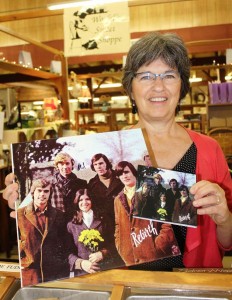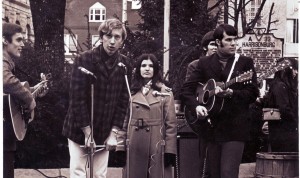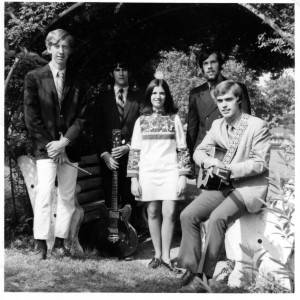“Rebirth.” Merely mentioning the word opens a floodgate of great memories for the five members of the music group bearing that name – James Krabill, Mel Lehman, Elaine Warfel Stauffer, Dean Clemmer and Rob Eby. As students at Eastern Mennonite College, their music took the campus, the larger Mennonite community and beyond by storm.
Now, some 45 years after the group disbanded, their distinctive sound is back with the re-release of their third and final self-titled album. Only this go-round, the recording is available as a compact disc and as a digital download. Proceeds of the sales benefit the Sadie A. Hartzler Library.
[Order the CD or watch a video to hear songs and see more photos of the group.]
Glenn Lehman, director of Harmonies Workshop of Leola, Pa., is the producer of the re-released album. In orchestrating the project, he cleared all music copyrights, chose the recording engineer and CD cover design and is marketing the disc. Glenn’s son, Joel, was recording engineer, and Jay Messina, a recording engineer on the original album, was technical advisor on the digital re-mastering.
“Harmonies’ primary focus is promoting and performing church and choral music, live and recorded,” Lehman said. “But we don’t want to be tunnel-visioned. Bringing back Rebirth seems like a good way to acknowledge and celebrate the group’s contribution to the broader church music arena.”

“They were first and foremost excellent musicians,” Lehman added. “They believed in and respected the music they created and the audiences they performed it for.”
Singers bring a capella tradition
Elaine Warfel Stauffer, a 1973 EMC graduate who lives in Hinton, Va., and has operated Warfel’s Sweet Shoppe at the nearby Dayton Market for 23 years, remembers well how Rebirth got started.
“I was in a music theory class with Dean Clemmer, who invited me to do some folk songs at a school social with him and another student, Harley Derstine. We hit it off immediately, she said. “We heard Jim Krabill perform his song, ‘Into the Light,’ liked what we heard and he wound up joining what became Rebirth, along with Mel Lehman and Rob Eby. We ended up playing together more than two years.”
Eby, a 1971 graduate currently living in Scottdale, Pa., has spent the last 20 years in the behavioral health counseling field. He played electric bass and occasionally lead guitar and brought a background of 1960’s rock and roll musicianship and energy to the group. Other Rebirth members brought backgrounds in folk, country, gospel, classical and contemporary Christian genres.
“All of us were steeped in the four-part harmony, a cappella tradition,” Eby noted. “That amalgamation seemed to provide something for nearly everyone in audiences.”
Gwen Stamm, Rob Eby’s spouse, calls the Rebirth phenomenon “a Kairos moment … it all happened at the right place at the right time.
“People were ready for Rebirth; they fulfilled a desire for something different in musical expression,” Stamm said. “Mennonite young people drank in their on-the-edge music. We felt an affinity with them, especially with their coming from a Mennonite college. They pulled young audiences, Mennonite and beyond, together, creating lasting memories.”
“Dean Clemmer was the quiet, behind-the-scenes group member,” Glenn Lehman stated. “But he was the musical brains who helped shape the group’s distinctive sound.”

“Lyrically, we combined the sacred and secular in our music,” Clemmer said. “I think that earlier for most Mennonites it would have been either/or, not both/and. Rebirth, along with Jerry Derstine’s Colorado-based Hallam Street Band, was among the first folk-rock groups to gain exposure to a wider audience, Mennonite and beyond.”
First album recorded in 1970
The group played on Court Square, Harrisonburg, during the “miracle fund drive” of Dec. 4-7, 1969, when EMC students worked to raise $111,000 in four days to rescue a threatened library project. Mel Lehman wrote a musical narrative of the event, “The Ballad of the EMU Library,” which they performed at groundbreaking ceremonies on Dec. 17 for what would become the Sadie A. Hartzler Library, completed and opened the fall of 1971.
Rebirth recorded its first album, ‘Into the Light,” in early 1970 in Harrisonburg. It contained mostly original selections, several classic folk songs and Ralph Carmichael’s meditative “Quiet Place.” Their second and third releases, both self-titled “Rebirth,” were recorded late 1970 at state-of-the-art studios in Atlanta, Ga., and spring of 1971 in New York City. The latter album omits three secular numbers, “People Gotta Be Free/I Wanna Be Free,” “Proud Mary” and “Summertime.”
The group went on two tours, the first to the West Coast the summer of 1970, playing to church youth groups of many denominations, high school audiences and Jesus people coffee houses. The winter of 1971, they toured through the Midwest under the auspices of Youth for Christ national youth ministry.
“The Mennonite Church was in major transition during this time, emerging from rather closed communities to more engagement with the world,” James Krabill stated. “Rebirth became somewhat of symbol, I think, of what that engagement could look like.
“We were essentially a ‘Christian’ band, doing a large percentage of faith-based songs and sharing rather openly how our faith intersected with the contemporary world and music we were performing,” he added.
Second tour becomes independent study course
Krabill noted that during the group’s second tour in 1971, EMC helped them design an independent study curriculum with required readings on the early-70s “counter culture” along with keeping daily journals of personal reflections of their experiences on the road and their studies.
“In retrospect, this was an extremely creative and cutting-edge initiative on EMC’s part, and, I believe, helped hold us accountable to the church and to the educational institution we rather publicly and openly represented,” Krabill said.
When graduation loomed for some band members, the group concurred, “Let’s quit while we’re on a roll.” And, they did.
James Krabill attended EMC 1969-71, spent a semester in Germany and finished at Goshen (Ind.) College. He and spouse Jeanette Neff Krabill live in Elkhart, Ind., where Krabill serves as senior executive for global ministries at Mennonite Mission Network
Mel Lehman, a 1971 EMC graduate, does peacemaking work with Common Humanity, an organization that seeks to help Americans building understanding, respect and friendship with the Arab and Muslim world through art.
Dean Clemmer graduated from EMC in 1972 and has been a psychotherapist for almost 35 years in Lancaster, Pa., currently with the Samaritan Counseling Center.
‘Hours of Mennonite love, joy, peace…’
For three members of Rebirth – James Krabill, Dean Clemmer and Rob Eby – the periodic gathering, concerts and recordings of the Reunion Vocal Band, a group of Mennonite musicians having roots in the music of the 1960s, has in some ways replaced the need to get Rebirth back together.
“If we ever do anything in the future, it probably makes most sense to do a small set of songs in the context of a Reunion Vocal Band concert,” Krabill said.
“’Rebirth’ brings back such excellent memories – the great friends I performed and traveled with and of course all the wonderful audiences – hours of Mennonite love, joy, peace and happiness and music-making,” Mel Lehman said. “I’d do it all again in a heartbeat.”
The CD recording is available at www.rebirthforsale.com. Any proceeds after expenses will benefit the Sadie A. Hartzler Library at EMU.
Portions of this article were published in the June 6, 2016, issue of the Mennonite World Review.

It was a real blast from the past to write this article. It started out as a glorified news release at the request of Mennonite World Review and, thanks to the amazing responses from all five Rebirth members, evolved into a ‘historic’ feature article. Glenn Lehman told me that I was the first person to order a copy of the re-released digital CD album. The group sounds even better than they did 45 years ago, and that’s saying something. So pleased that the EMU communications folks – the department I worked for for 40 years – picked up and reprinted the entire story. Get a copy – or more – of the CD, relive some great musical memories and in the process, help out the building that you all spent many happy hours in, Hartzler Library.